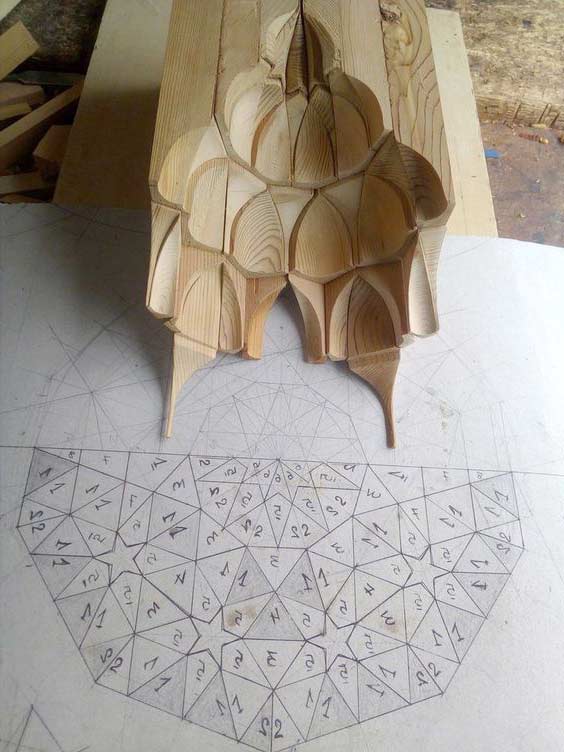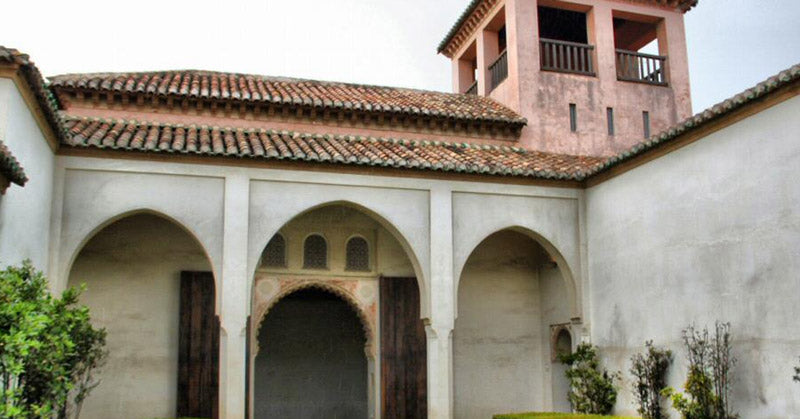25 abril, 2023
Muqarnas, an ornamental element of Islamic architecture
The Iberian Peninsula was conquered by the Muslims in 711 AD, and since then a lasting Islamic presence has been established in the region. Over the centuries, the Muslims built a large number of monuments, many of which feature the characteristic muqarnas decoration.
What are muqarnas?

Muqarnas are a common feature of Islamic architecture, and can be found in many Arabic Islamic monuments in Spain. It is said that the origin of the muqarnas is Arabic, and that they were used to decorate the ceilings of mosques.
The muqarnas are made of metal, porcelain or glass, and are round or flower-shaped. They are placed on the ceilings or walls of houses and buildings. In some places, muqarnas are used to decorate cars.
The muqarnas are one of the most characteristic decorations of Arab architecture. They are a kind of conical or wedge-shaped stalactites that hang from the ceiling of a room. The characteristic shape of these ornaments is due to the fact that they were built from clay molds.
What were muqarnas used for?
Muqarnas were mainly used in religious monuments, as they were considered to be a symbol of God's presence. However, they could also be found in other buildings, such as palaces and stately homes.

The muqarnas were geometric designs that were made with a very special technique. These designs were made on the walls of buildings to give them a touch of elegance and beauty. The way these designs were made was very complicated and required a lot of precision and skill. They were made using a technique called "intarsia", which consisted of joining pieces of wood of different colors to form a design. This technique was very popular at the time and was used to decorate many buildings.
When did muqarnas appear?
According to tradition, muqarnas were created by the caliph al-Hakam II to decorate the mosque of Cordoba, and have become a symbol of Islamic architecture in general.
What materials were used to make the muqarnas?
Muqarnas are a traditional form of decorative art used to adorn walls and ceilings. They are made from a variety of materials, including plaster, wood and ceramics.

Plaster is the most commonly used material for making muqarnas, as it is easy to work with and can be shaped into any desired form. Wood is also often used, especially in the older versions of these ornaments. Ceramics are less commonly used, but can also be used to create unique and beautiful muqarnas.

Examples of muqarnas decorations in Spanish monuments
Alhambra of Granada

The Alhambra in Granada is one of the most visited Islamic monuments in Spain.
In the Alhambra of Granada we can find one of the best examples of Moorish decoration. This is the Moorish Hall, located in the north wing of the palace. This room is characterized by a ceiling completely covered with muqarnas.
Another example of an Islamic monument with muqarnas decoration in Spain is the ceiling of the Hall of the Two Sisters, located in the Alhambra in Granada. This ceiling is formed by two large wooden domes decorated with muqarnas.
In general, we can say that muqarnas are a characteristic element of Islamic architecture and that, in Spain, we can find some of the best examples of this type of decoration.
The Alcazar of Seville

Islamic monuments in Spain are some of the most beautiful in the world, and many of them have muqarnas decoration. The Alcazar of Seville is one of the best examples of this, and the Hall of Ambassadors is one of its jewels.
The star-shaped muqarnas decoration is one of the most impressive features of this monument. The Hall of the Abencerrajes in the Alcázar Palace in Seville is also a magnificent example of Moorish decoration.
The Mosque of Cordoba

This is one of the largest mosques in the world, built in the 8th century. The mosque is decorated with numerous Moorish motifs, which give it a unique and incomparable touch. The Mosque of Cordoba is a perfect example of an Islamic monument with an impressive muqarnas dome.
The Giralda of Seville

The Giralda of Seville is one of the most emblematic monuments of the city. It is the former minaret of the city's mosque, which was converted into a cathedral after the Christian reconquest. The Giralda has a height of 97 meters and is decorated with beautiful Moorish motifs.
The Golden Tower of Seville

The Torre del Oro of Seville is an example of monuments that have muqarnas decoration. The first Almohad muqarnas capitals were built in the 12th century. These Islamic monuments are proof of the influence that Islam had in Spain.
The city of Medina Azahara
Another example of the use of muqarnas in Islamic architecture is the city of Medina Azahara, located near Cordoba. Medina Azahara was built in 936 AD, and is a good example of Muslim architecture of the time. The city is decorated with muqarnas in a wide variety of elements, from door arches to column capitals.

Muqarnas are also used in Islamic architecture of the medieval period, as in the Nasrid capitals of ataurique and muqarnas. Nasrid capitals are a type of Islamic architecture that developed in the Iberian Peninsula during the medieval period. These capitals are characterized by their muqarnas decoration, which was used to decorate the arches of doors and windows.
The Aljafería Palace of Zaragoza

The Aljafería Palace in Zaragoza is one of the most important Islamic monuments in Spain. It is an 11th century building that was originally the residence of the governor of the city. Today, the palace is in ruins, but it is still possible to admire its magnificent Moorish decoration.
The Alcazaba of Malaga

The Alcazaba of Malaga is another example of Moorish decoration, and its Mudejar Armor Hall is an octagonal centerpiece decorated with a pineapple of muqarnas.
The Mosque and the Oratory of San Miguel of Cuenca

The Mosque and Oratory of San Miguel de Cuenca is an 11th century Islamic monument located in the city of Cuenca. The mosque was originally built as a Christian church, but was adapted to be a mosque during Islamic times. The mosque is decorated with splendid Moorish decoration, which is especially prominent in the interior of the oratory.
In Spain, there are numerous Islamic monuments with magnificent Moorish decoration. These monuments bear witness to Islamic history and culture in Spain, and are one of the country's main tourist attractions.
Living in Andalusia, and seeing many of these decorative elements, it is easy to understand why the products we make and sell in our online store are so influential.
A clear example of the Andalusian influence in our products are our scarves and foulards.